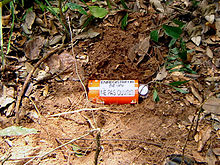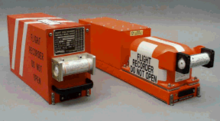- Cockpit voice recorder
-
 Cockpit voice recorder (on display in the Deutsches Museum). This is a magnetic tape unit built to an old standard TSO C84 as shown on the nameplate. The text on the side in French "flight recorder do not open"
Cockpit voice recorder (on display in the Deutsches Museum). This is a magnetic tape unit built to an old standard TSO C84 as shown on the nameplate. The text on the side in French "flight recorder do not open"
 Brazilian investigators found the cockpit voice recorder module of PR-GTD, a Gol Transportes Aéreos Boeing 737-8EH SFP, in the Amazon in Mato Grosso, Brazil. The airliner, while on Gol Transportes Aéreos Flight 1907, collided with a business jet, nosedived, broke up in-flight, and crashed.
Brazilian investigators found the cockpit voice recorder module of PR-GTD, a Gol Transportes Aéreos Boeing 737-8EH SFP, in the Amazon in Mato Grosso, Brazil. The airliner, while on Gol Transportes Aéreos Flight 1907, collided with a business jet, nosedived, broke up in-flight, and crashed.
A cockpit voice recorder (CVR), often referred to as a "black box",[1] is a flight recorder used to record the audio environment in the flight deck of an aircraft for the purpose of investigation of accidents and incidents. This is typically achieved by recording the signals of the microphones and earphones of the pilots headsets and of an area microphone in the roof of the cockpit. The current applicable FAA TSO is C123b titled Cockpit Voice Recorder Equipment.[2]
Where an aircraft is required to carry a CVR and utilises digital communications the CVR is required to record such communications with air traffic control unless this is recorded elsewhere. As of 2005[update] it is an FAA requirement that the recording duration is a minimum of thirty minutes,[3] but the NTSB has long recommended that it should be at least two hours.[4]
Contents
Overview
A standard CVR is capable of recording 4 channels of audio data for a period of 2 hours. The original requirement was for a CVR to record for 30 minutes, but this has been found to be insufficient in many cases, significant parts of the audio data needed for a subsequent investigation having occurred more than 30 minutes before the end of the recording.
The earliest CVRs used analog wire recording, later replaced by analog magnetic tape. Some of the tape units used two reels, with the tape automatically reversing at each end. The original was the ARL Flight Memory Unit produced in 1957 by Australian David Warren and an instrument maker named Tych Mirfield.
Other units used a single reel, with the tape spliced into a continuous loop, much as in an 8-track cartridge. The tape would circulate and old audio information would be overwritten every 30 minutes. Recovery of sound from magnetic tape often proves difficult if the recorder is recovered from water and its housing has been breached. Thus, the latest designs employ solid-state memory and use digital recording techniques, making them much more resistant to shock, vibration and moisture. With the reduced power requirements of solid-state recorders, it is now practical to incorporate a battery in the units, so that recording can continue until flight termination, even if the aircraft electrical system fails.
Like the flight data recorder (FDR), the CVR is typically mounted in the tail section (the empennage) of an airplane to maximize the likelihood of its survival in a crash.[5]
Although it is commonly believed that Flight Data Recorders and Cockpit Voice Recorders are required on all US aircraft, in fact, they are only required on US aircraft that have 20 or more passenger seats or those that have six or more passenger seats, are turbo-charged, and require two pilots.[6]
History
The CVR was developed in the 1950s chiefly in Australia. In 1960, following an aircraft crash in Queensland, the inquiry judge strongly recommended that flight recorders be installed in all airliners. Australia became the first country in the world to make cockpit-voice recording compulsory.[7][8]
Future devices
The U.S. National Transportation Safety Board has asked for the installation of cockpit image recorders in large transport aircraft to provide information that would supplement existing CVR and FDR data in accident investigations. They also recommended image recorders be placed into smaller aircraft that are not required to have a CVR or FDR.[4]
Such systems, estimated to cost less than $8,000 installed, typically consist of a camera and microphone located in the cockpit to continuously record cockpit instrumentation, the outside viewing area, engine sounds, radio communications, and ambient cockpit sounds. As with conventional CVRs and FDRs, data from such a system is stored in a crash-protected unit to ensure survivability.[4]
Since the recorders can sometimes be crushed into unreadable pieces, or even located in deep water, some modern units are self-ejecting (taking advantage of kinetic energy at impact to separate themselves from the aircraft) and also equipped with radio emergency locator transmitters and sonar underwater locator beacons to aid in their location.
On 19 July 2005, the Safe Aviation and Flight Enhancement Act of 2005 was introduced and referred to the Committee on Transportation and Infrastructure of the U.S. House of Representatives. This bill would require installation of a second cockpit voice recorder, digital flight data recorder system and emergency locator transmitter that utilizes combination deployable recorder technology in each commercial passenger aircraft that is currently required to carry each of those recorders. The deployable recorder system would be ejected from the rear of the aircraft at the moment of an accident. The bill was referred to the House Subcommittee on Aviation during the 108th, 109th, and 110th congresses.[9][10][11]
Related
The U.S. National Transportation Safety Board has recommended that railroad voice recorders be required in locomotives.[12]
Cultural references
The Neue Deutsche Härte band Rammstein's album Reise, Reise is made to look like a CVR; it also includes a recording from a crash. The recording is from the last 1–2 minutes of the CVR of Japan Airlines Flight 123, which crashed on August 12, 1985, killing 520 people; JAL123 is the deadliest single-aircraft disaster in history.
Members of Collective: Unconscious made a theatrical presentation[13] of a play called Charlie Victor Romeo with a script based on transcripts from CVR voice recordings of nine aircraft emergencies. The play features the famous United Airlines Flight 232 that landed in a cornfield near Sioux City, Iowa after suffering a catastrophic failure of one engine and most flight controls.
Survivor, a novel by Chuck Palahniuk, is about a cult member who dictates his life story to a flight recorder before the plane runs out of fuel and crashes.
See also
- Acronyms and abbreviations in avionics
- Air safety
- Black box (transportation)
- Distress radiobeacon, (EPIRB), (ELT)
- Flight data recorder
- List of unrecovered flight recorders
References
 This article incorporates public domain material from websites or documents of the National Transportation Safety Board.
This article incorporates public domain material from websites or documents of the National Transportation Safety Board.- ^ "France to resume 'black box' hunt". BBC News. 2009-12-13. http://news.bbc.co.uk/1/hi/world/europe/8410375.stm. Retrieved 2010-04-30.
- ^ "Cockpit Voice Recorder Equipment" (PDF). Federal Aviation Administration. 2006-06-01. http://rgl.faa.gov/Regulatory_and_Guidance_Library/rgTSO.nsf/0/29662c3b5885d29386257180007150b6/$FILE/TSO-C123b.pdf. Retrieved 2007-04-21.
- ^ Federal Aviation Regulation Sec. 121.359 - Cockpit voice recorders
- ^ a b c "Most Wanted List" NTSB
- ^ Federal Aviation Regulation Sec. 23.1457 - Cockpit voice recorders
- ^ NTSB.gov
- ^ "Dave Warren - Inventor of the black box flight recorder ", DSTO-dsto.defence.gov.au, 29 March 2005, Retrieved 20 April 2010
- ^ Neil Campbell, The Evolution of Flight Data Analysis, Proc. Australian Society of Air Safety Investigators conference, 2007, visible here
- ^ 108th Congress House Resolution 2632 THOMAS (Library of Congress)
- ^ 109th Congress House Resolution 3336 THOMAS (Library of Congress)
- ^ 110th Congress Resolution 4336 THOMAS (Library of Congress)
- ^ "Data Collection and Improved Technologies" NTSB
- ^ Collective: Unconscious
External links
- 'The ARL ‘Black Box’ Flight Recorder' — Melbourne University history honours thesis on the development of the first cockpit voice recorder by David Warren
Categories:- Avionics
- Aircraft recorders
Wikimedia Foundation. 2010.


